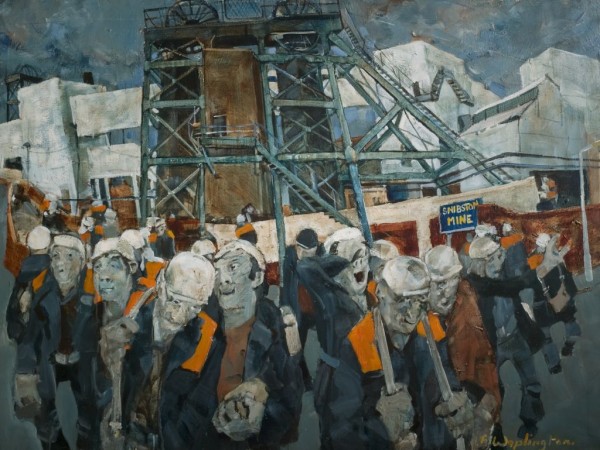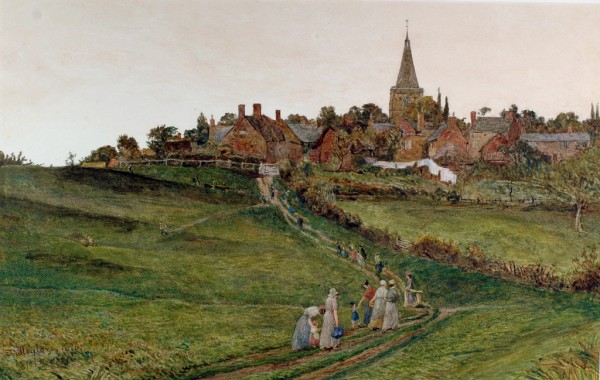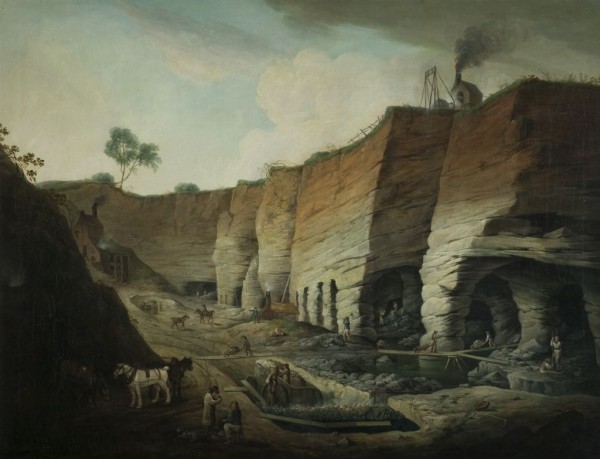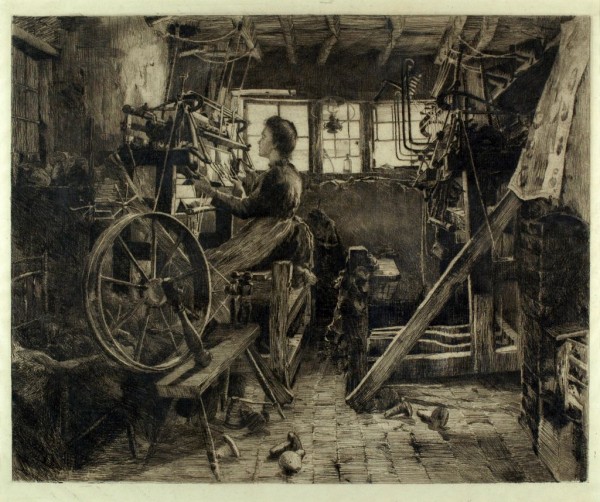The Art of Work
Artists have been creating images of Leicestershire people at work for many centuries. The collections contain pictures of servants, agricultural workers, coal miners, factory workers, tradespeople and professionals from the late eighteenth century through to the late twentieth century. Some pictures show an idealised view of working life, others are more 'real' reflecting hard graft and tiredness at the end of a long working day. Together with our Working Life collections they help us show the changes - and continuity - of some of the county's crafts, trades and industries.

Snibston Mine by Paul Waplington, 1980s.
Paul Waplington spent time at Snibston mine creating images of the miners and the colliery architecture. The collections include some of his drawings as well as this oil painting. It shows the end of shift at Snibston colliery in Coalville - the Leicestershire town that owed its name and existence to coal and the mine that George and Robert Stephenson sank to bring it to the surface. The miners are crossing over the Ashby Road and heading for the baths that were built opposite the headstocks and coal processing plant that dominate the background of the painting and the skyline of the town.


Tubes Factory, Desford, Leicestershire 1974 by Anton Mark Ferrow
The Tubes Factory at Newtown Unthank near Desford was part of the Tubes Investments Company (later TI). Its rolling and bearing tube mills made heavy duty metal tubes for many different industries. By 1969 the Desford works were the most advanced and integrated plant for making roll and bearing tubes. Five years after this picture was painted Desford Tubes won the Queens Award for Export. The picture shows part of the tube mill with hot metal being formed into long cylinders whilst the workers control the process and wait to move the tubes through the various process within the factory. The heat of the mills and furnaces cast an orange glow across the picture.


The Path to the Village - Tilton on the Hill by John Fulleylove
Leicester-born John Fulleylove painted many watercolours around Leicestershire in the last part of the nineteenth century. In this picture he shows a group of women and children walking along the path back to the village. Some of them are carrying bundles but it's hard to see what these are. Perhaps there are some clues in the painting? In the garden of the house to the right of the path there is a washing line full of clean laundry. Perhaps it's wash day and the women are bringing bundles of clothes up from the river or stream where they have been doing the hard work of laundry by hand. Or maybe they have taken food down to their families working in the fields around the village? Whatever they have been doing this is one of a few images of women at work that we have in the collections.


Dimmingsdale Quarry around 1810 (Artist unknown)
The Dimmingsdale quarries were part of Earl Ferrer's estate at Staunton Harold. The quarries were created to remove the valuable limestone from the ground, which was dug out by hand, creating vast man-made 'caves' which disappeared into the side of the quarry. As quarrying continued lead was discovered and this was also mined alongside the quarried limestone. The pictures shows the various labours needed to extract the minerals: Men using picks and shovels are working in the cave mouths whilst others move the rock in wheelbarrows (some working on wooden walkways over flooded areas of the quarry). The barrows are unloaded into carts and horses are waiting to pull the carts out of the quarry. The discovery of minerals including lead and coal beneath their estates made many land owners incredibly wealthy during the late eighteenth and nineteenth centuries. New mining and quarrying communities grew up as people left their homes and jobs in other parts of the country to come and work in the new industries. Hard physical work, poor conditions, danger and poor pay made mining a tough job.


A Framework Knitter at Work 1891 by Mary Sloane
Knitting both by hand and machine has a long history across Leicestershire. Leicester had the largest knitting industry but there were factories and workshops across the county. William Lee had invented a machine which could knit using multiple needles during the reign of Queen Elizabeth I but it wasn't until the 1700s that people began to use these knitting frames in large numbers. Sometimes working in their own homes and sometimes working on frames gathered together in workshops, stocking makers or 'Stockingers' worked long hours for poor pay. The knitting workshops continued well into the early twentieth century - this etching probably dates from 1891 (there is a watercolour version in Leicester's Museum collections) - but the expansion of factory based mass production and new technologies meant that the knitting frame became obsolete for all but craft production.


Nailstone Study for Oil. Pen and ink drawing by Noel Brannan (1921-2001), 1991.
Noel Brannan was born in Northumberland in 1921, both his father and brother were keen artists. After studying at Lincoln and Leicester School of Art, he took a teaching job in Hinckley in 1952. He lived in and sketched Leicestershire’s landscape until his death in 2001.
He had a great love of industrial landscapes such as mines, tile works, chimneys, quarries, canals and areas of wasteland, which were his favourite sketching ground. He sketched and painted Nailstone Colliery prior to its demolition in 1991.

